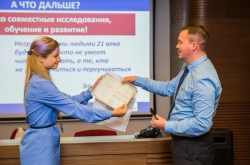Aimed at researchers from the fields of informatics, social sciences, and management, SocInfo is a multidisciplinary forum which gives participants the opportunity to exchange ideas, share knowledge, and present their topical research on the interaction between socially-oriented platforms and social phenomena. That is because fundamentally, social informatics’ main goal is to contribute to better understanding of socially-oriented platforms not only as a technological solution but also as a set of social phenomena. Speakers weigh in on the use of IT in social data analysis, debate social concepts that lay the foundation for information systems design and ponder over ways to apply computing algorithms to facilitate research in the field of social sciences.
ITMO University’s eScience Research Institute and Bank Saint Petersburg began collaborating a year ago. Interested in the prospect of being able to forecast customer spending, the bank representatives provided ITMO’s researchers with comprehensive data on their 192,000 clients’ transactions, coupled with information on their age and gender. The transactions in question date back to the period from January 2012 to February 2014, amounting to 31,691,000 in total.
“This project is a result of the long-standing cooperation between our two organizations. When embarking on this journey, our primary concern was how to use the customers’ data without compromising their safety and in full compliance with associated ethical and legal requirements, so we put a lot of time and effort into figuring this out. Now we’re trying to understand what exactly we want from the extensive data at hand. Full details haven’t been discussed yet as our main goal at this stage is to gauge our abilities and combine the data we received with the information garnered from the customers’ social media accounts. This alone presents a host of challenges, but it’s only when we align all the data will we be able to make exact forecasts and recommendations,” explained Danila Vaganov.

Social media are used for drawing a fuller and more accurate picture of a customer’s interests and background. The bank will consider these findings when making this client an offer.
According to the expert, the data provided and social media study conducted by the research team allowed for a conclusive analysis of specific behavioral trends, social strata, age groups, and product categories attracting the most spending. The bank representatives are now evaluating the primary findings to identify the project’s next steps.
“The project’s future depends on the feedback we receive from the bank: there may be some tweaks we’ll have to do to make the most of the data. But notwithstanding the possible changes, customers’ safety will always remain our number-one priority: people shouldn’t think that they’re being spied upon. Bank Saint Petersburg will never steer away from the ethical and conscientious customer policy it prides itself in,” underlined the researcher.

The bank plans to use the obtained results to develop tailor-made special offers, promo deals, and cashback opportunities to suit each client’s interests. Customers’ responses will be analyzed to establish which of the offers generated the largest demand.
“The biggest challenge we face is that from the scientific point of view, there is too broad a range of ways a client can behave. To put it roughly, it’s impossible to second-guess what a client will do or buy tomorrow; there are too many options for us to be able to do that. What we need is a clear-cut, formalized task to guide us towards a clearer understanding of what we’re looking for,” said Danila.
The researchers draw on basic data processing technologies and different clusterization methods to create model spending patterns and estimate the probability of a client choosing to transition between them in specific cases. Further research options include experimenting with different machine learning and time series forecasting techniques, as well as switching to high-precision probability processes instead of simple frequency rules to reach a more sophisticated understanding of complex correlations between the time-steps.

“I developed an analytical system to register the transitions between customers’ monthly spending patterns. A client may only purchase kids’ toys, food, and petrol in one month and up their expenses by frequenting pricey restaurants in another, and the research we carried out enables us to respond to these changes. It may well be that other customers have exhibited such behavior patterns before, and studying their experiences will give us cues that next month, the client in question will go heavy on clothes, for example. My own research revolves around the search for these evolutionary correlations: which factors will bring about which purchases and so on. While most people initially demonstrate similar spending choices, we have to factor in the specific social and demographic variables to forecast other spendings beyond the usual bread-and-butter,” commented the student.
Several eScience Research Institute’s departments joined their forces to work on the project. All participants were set different tasks: some are busy sorting out data, others process it, but they will combine their findings to bring the project to its conclusion.





